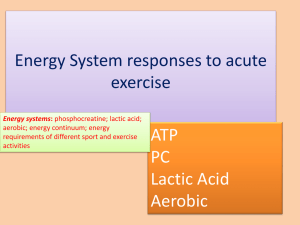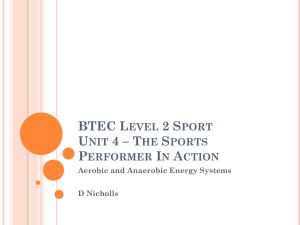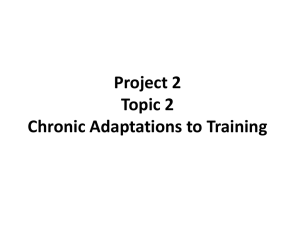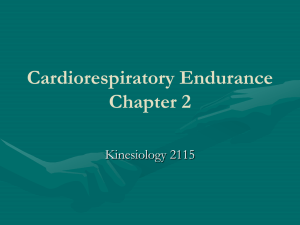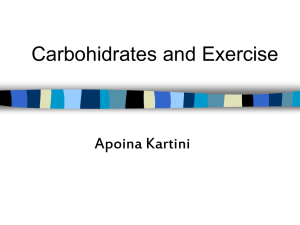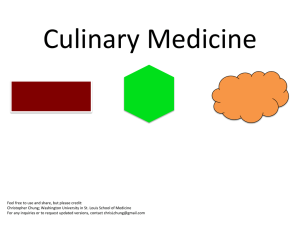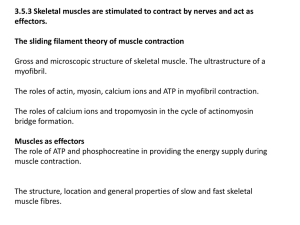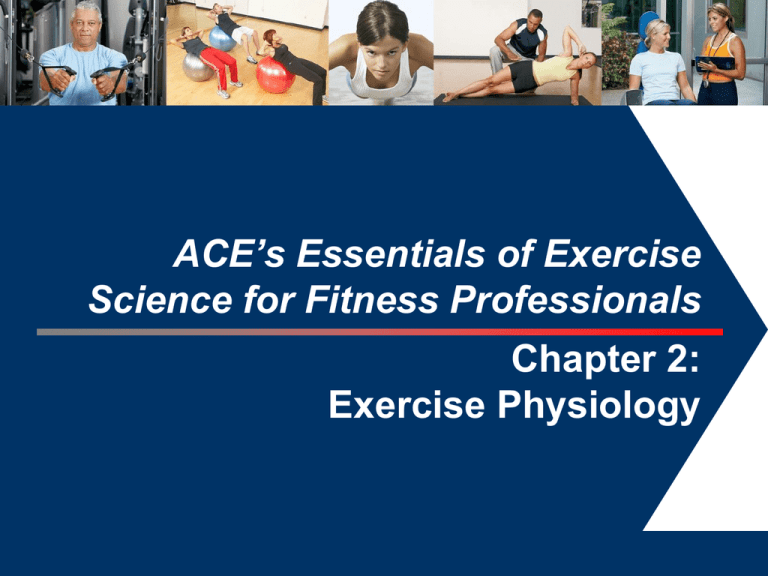
ACE’s Essentials of Exercise
Science for Fitness Professionals
Chapter 2:
Exercise Physiology
1
Learning Objectives
This session, which is based on Chapter 2 of ACE’s Essentials of
Exercise Science for Fitness Professionals, covers how the body
responds to the demands of exercise at the cellular level and the
physiological adaptations that occur with specific training programs.
After completing this session, you will have a better understanding
of:
– The components of fitness
– The physiology of the cardiorespiratory system
– The aerobic and anaerobic energy pathway systems
– Acute and chronic responses to aerobic training
– The physiological adaptations to strength training
– Hormonal responses to exercise
– Environmental considerations when exercising
Introduction
Exercise requires increased energy to fuel the body’s
movements. Exercise physiology is the study of how the body
responds to those acute and chronic demands.
Regular exercise is linked to the prevention and treatment of
most diseases. Benefits include:
– Improved cardiovascular function
– Lowered systolic and diastolic blood pressure
– Decreased body weight and fat mass
– Improved lipid profile
– Improved glucose control
– Decreased anxiety and depression
30 minutes a day of moderate-intensity exercise is
recommended for reducing the risk of lifestyle diseases.
Physical Fitness
Components of physical fitness
– Muscular strength
– Muscular endurance
– Cardiorespiratory endurance (aerobic fitness)
– Flexibility
– Body composition
Physiology of the Cardiorespiratory System
For muscles to contract, they need energy in the form of ATP. The
cardiorespiratory system is responsible for the three basic
processes to produce this energy:
– Get oxygen into the blood (oxygen-carrying capacity)
– Deliver oxygen to the muscles (oxygen delivery)
– Extract the oxygen from the blood to form ATP (oxygen extraction)
Oxygen-carrying capacity is affected by two primary functions: (1)
the ability to adequately ventilate the alveoli in the lungs and (2)
hemoglobin concentration in the blood.
Oxygen Delivery
Oxygen delivery is a function of cardiac output (the quantity of blood
pumped per minute).
– Cardiac output (Q) = Stroke volume (SV) x Heart rate (HR) (in beats per
min)
• Stroke volume is the amount of blood pumped during each heartbeat.
– Cardiac output increases due to increases in both SV and HR.
• HR typically increases in a linear fashion up to maximal levels.
• SV increases to about 40–50% of maximal capacity, and then plateaus.
Oxygen Extraction
Oxygen extraction from the blood at the cellular level depends on
muscle fiber type and the availability of specialized oxidative
enzymes.
– Slow-twitch muscle fibers are specifically adapted for oxygen extraction
and utilization.
– Aerobic production of ATP occurs in the mitochondria of the cells.
– The circulatory system increases blood flow to the active muscles and
decreases blood flow to non-active areas such as the viscera, allowing
a higher concentration of O2 to be extracted.
Supplying the Body With Energy
The body’s cells require energy in the form of ATP. Since only a small amount of ATP is
stored in the body, food (fat, carbohydrates, and protein) must be broken down into its
simplest components (fatty acids, glucose, and amino acids, respectively), which are used
to produce ATP or stored for later use.
The figure below breaks
down the conversion of foods
from their ingested forms to ATP.
Energy Systems Available During Exercise
There are three primary energy systems that supply the body with ATP
during exercise.
1. Phosphagen system (anaerobic)
• Involves the breakdown of creatine phosphate (CP) and stored ATP to
resynthesize ATP for immediate use.
2. Anaerobic glycolysis
• Involves the breakdown of glucose and glycogen to form ATP
3. Aerobic glycolysis
• When sufficient oxygen is available, more ATP can be produced via the
breakdown of carbohydrates and fat.
• The aerobic metabolism of fat yields larger amounts of ATP compared to
glucose (fat = 9 kcal/gram; carbohydrate = 4 kcal/gram).
• Because carbohydrate metabolism requires less oxygen than fat
metabolism, the body will use more glucose and less fat for energy as
exercise intensity increases.
Breakdown of Fat and Glucose Metabolism
The figure below illustrates the pathway of glucose (anaerobic and aerobic
oxidation) and fat (beta oxidation) in their conversion to ATP.
Respiratory Exchange Ratio
The respiratory exchange ratio (RER) is the ratio of carbon dioxide produced
relative to the amount of oxygen.
– RER = Carbon dioxide/Oxygen consumed
– RER is a marker for the proportion of fat or carbohydrate being used for fuel at
different intensities during steady-state exercise.
– At rest, the average RER is 0.75, meaning that the body is burning approximately
85% fat and 15% carbohydrate. As intensity increases, so does RER, meaning a
larger percentage of carbohydrate is being burned and a lesser percentage of fat.
– The use of RER has been linked to a common misconception that low-intensity
exercise is the best way to lose more weight because it burns more fat.
Oxygen Consumption
The more oxygen a person can take in, deliver, and
utilize, the more work he or she can perform.
VO2max refers to one’s maximal oxygen consumption.
– It is expressed in either “relative” terms (mL/kg/min) or “absolute”
terms (L/min).
– Relative VO2max allows comparisons between individuals.
Absolute VO2max is used to determine caloric expenditure
during specific activities.
• Approximately 5 kcal of energy are burned for every liter of oxygen
consumed.
Oxygen Consumption During Aerobic Exercise
As soon as aerobic exercise begins, more ATP is required. To meet this
demand, the body’s sympathetic nervous system takes over and stimulates
an increase in cardiac output and the release of epinephrine and
norepinephrine, which prepare the body for increased metabolic demands.
Once exercise begins, it takes two to four minutes for the body to meet the
increased metabolic demand of oxygen.
– During this time, the anaerobic energy systems take over.
When the cardiorespiratory system has fully taken over, a new level of
steady-state oxygen consumption is achieved.
Return of Oxygen to Resting Levels
Once exercised has stopped, oxygen levels slowly return to resting levels.
– Cardiac output, blood pressure, and ventilation return to resting levels.
– Oxygen consumption slowly declines, but remains elevated above resting level—
excess post exercise oxygen consumption (EPOC).
• During this time,
phosphagen stores
are being replenished,
remaining lactate is
being removed from
the blood, the
metabolic rate
decreases, etc.
Anaerobic Threshold
The anaerobic threshold (AT) is reached when exercise
intensity increases above steady-state aerobic
metabolism and anaerobic production of ATP occurs.
When the AT is crossed, exercise can only be sustained
for a few minutes before hyperventilation begins to
occur.
– Lactate accumulates progressively in the blood and the oxygen
deficit and corresponding EPOC are extremely high.
– At this point, the body attempts to rid excess CO2 (a by-product
of acid metabolites). The increase in respiration is called the
second ventilatory threshold (VT2).
– VT2 is an indirect indicator of AT.
Ventilatory Threshold
There are two distinct changes in breathing patterns during incremental exercise: the
first ventilatory threshold (VT1) and the second ventilatory threshold (VT2).
VT1 occurs as soon as blood lactate begins to accumulate and the body needs to rid
itself of excess CO2 through increased respiration.
–
Can be identified using the “talk test.” It is the first point at which it becomes noticeably more
difficult to speak.
VT2 occurs as blood lactate rapidly
increases with intensity, and represents
increased hyperventilation past the need
to rid the body of excess CO2.
–
Also known as lactate threshold (LT) and
respiratory compensation threshold (RCT)
–
Speaking is definitely not comfortable
at this intensity.
Training Levels
VT1 and VT2 are used to develop training programs for
both serious athletes and beginning exercisers.
– Serious athletes perform approximately 70–80% of their training
intensities below VT1, <10% between VT1 and VT2, and 10–
20% above VT2.
– For beginning exercisers, VT1 may serve as an appropriate
upper limit of exercise intensity.
Chronic Training Adaptations to Exercise
SAID principle (specific adaptation to imposed demands)
Examples include:
– Improved cardiac output efficiency (increased SV and lower HR) (aerobic
training)
– Increase in respiratory capacity (aerobic training)
– Increase in maximal oxygen consumption (aerobic training)
– Increase in bone density (weightbearing exercise)
– Improved control of blood glucose and lipids (physical activity)
– Maintained or improved lean body mass (weightbearing activity)
– Decreased depression and anxiety (physical activity)
– Higher quality of life (physical activity)
Neuromuscular Physiology
Nerves are made up of neurons (nerve cells)
– There are two types of neurons:
• Sensory neurons
• Motor neurons
Motor neurons connect (synapse) with the muscle at neuromuscular
junction (motor end plate).
A motor unit is made up of one motor neuron
and all of the muscle cells it innervates.
The number of muscle cells a motor neuron
innervates depends on the precision and
accuracy required of that muscle.
Muscle Fiber Types: Fast Twitch
Fast-twitch (FT) muscle fibers
– Utilize primarily the phosphagen and anaerobic glycolysis energy
systems
– Specialized for anaerobic metabolism
– FT motor units innervate more muscle fibers, allowing greater force
production.
Muscle Fiber Types: Slow Twitch
Slow-twitch (ST) muscle fibers
– Well equipped for oxygen delivery
– High number of oxidative enzymes
– High number of mitochondria; aerobic glycolysis and fatty-acid oxidation
– Used for low-intensity, longer-duration activities (e.g., walking, jogging,
swimming)
– Usually more abundant in fatigue-resistant muscles (e.g., postural
muscles)
Muscle Fiber Distribution
Muscle-fiber distribution is largely determined by
genetics.
– Most people have about equal percentages of FT and ST
fibers.
– Persons better at low-intensity endurance activities may
have a larger percentage of ST fibers. Persons better at
high-intensity, sudden bursts of activity probably have a
larger percentage of FT fibers.
– “Intermediate” fiber types have a high capacity for both fast
anaerobic and slow aerobic movements, and are adaptable
based upon the training stimulus.
Muscle Fiber Response to Training
All three muscle fiber types are highly trainable.
– Adapt to the specific demand placed on them
– Muscle fiber types are recruited sequentially in response to force
generation: ST then FT
– FT muscle fibers are more closely related to the hypertrophy
(increase in size) of fibers in response to a strength program.
– Muscular endurance training is specific to both ST and FT fibers
and motor units.
The Endocrine System
The endocrine system is responsible for releasing
hormones from glands into the circulation. These
hormones act on specific receptors to perform a number
of functions in the body, including:
– Regulating cellular metabolism
– Facilitating the cardiovascular response to exercise
– Facilitating transport across cell membranes (e.g., insulin)
– Inducing secretory activity (e.g., ACTH, cortisol)
– Modulating protein synthesis
Hormonal Response to Exercise
Hormones are necessary to help the body make acute
and chronic adaptations to exercise.
Some of the related hormones include:
– Growth hormone (GH)
• Secreted by the anterior pituitary gland
• Facilitates protein synthesis
• Mediated by insulin-like growth factors
Hormonal Response to Exercise (cont.)
– Antidiuretic hormone (ADH)
• Also called vasopressin
• Secreted by the posterior pituitary gland
• Reduces urinary excretion of water in response to the dehydrating
effects of sweat during exercise
– Epinephrine and norepinephrine
• Collectively called the catecholamines
• Secreted by the adrenal medulla as part of the sympathetic
response to exercise
• Two major roles:
– Increase cardiac output (increase HR and contractility)
– Stimulate glycogen breakdown in the liver (glycogenolysis)
Hormonal Response to Exercise (cont.)
– Aldosterone and cortisol
• Secreted by the adrenal cortex
• Aldosterone limits sodium excretion in urine to maintain electrolyte
balance.
• Cortisol promotes protein and triglyceride breakdown to aid in
maintaining blood glucose.
– Insulin and glucagon
• Secreted by the pancreas (specifically, the islets of Langerhans)
• Insulin is active when blood glucose levels are high to move glucose
from the blood to the tissues.
• Glucagon is active when blood glucose is low to stimulate glucose
release from the liver.
Hormonal Response to Exercise (cont.)
– Testosterone and estrogen
• Testosterone (male sex hormone) is secreted by the testes.
– Responsible for masculine characteristics and muscle-building
(anabolic) effects.
• Estrogen (female sex hormone) is secreted by the ovaries.
– Responsible for feminine characteristics and bone formation and
maintenance.
– May play a role in amenorrhea and the female athlete triad
Exercising in the Heat
In addition to exercising in a hot, humid environment, other factors
can cause heat overload.
– Poor hydration prior to exercise
– Overdressing
– Overweight and obesity
During exercise, the internal heat load is brought to the skin’s
surface to be cooled via the secretion of water by the sweat glands
(evaporation).
– The goal (given favorable environmental conditions) is to prevent body
temperature from rising more than 2 to 3°F.
– When the ability to dissipate heat is compromised, injuries occur.
Physiological Responses to Exercising in the Heat
Dissipating internal body heat is more difficult in the heat, resulting in a
higher heart rate than normal at any level of exercise to maintain cardiac
output.
A hot humid environment is the most stressful environment for exercising
and poses the risk of heat exhaustion and heat stroke.
Safety in the Heat
The heat index, as presented on the next slide, provides guidelines
on when exercise is safe and when it should be avoided.
Tips to consider before exercising in the heat:
– Begin gradually
– Always wear lightweight, well-ventilated clothing
– Avoid impermeable or non-breathable garments
– Replace body fluids as they are lost
– Record daily body weight
– Air movement is critical for adequate cooling
Heat Index
Exercising in the Cold
The excessive loss of body heat can lead to a generalized vasoconstriction
and conditions such as hypothermia, frostbite, and increased blood
pressure.
Strong wind can accelerate heat loss.
– The windchill index, which is presented on the following next, provides guidelines
for determining if exercise is safe.
Tips to consider before exercising in the cold:
– Wear several layers so that garments can be removed or replaced as needed
– Allow for adequate ventilation of sweat
– Wear garments made of materials that allow the body to give off body heat
during exercise and retain body heat during inactivity
– Replace body fluids in the cold, just as in the heat
– Monitor body weight over several days
Windchill Factor Chart
Exercising at Higher Altitudes
At moderate-to-high altitudes, the partial pressure of
oxygen in the air is reduced.
Acclimatization (physiological adaptation to an unfamiliar
or unaccustomed environment) begins in a couple
weeks, but it may take several months to fully
acclimatize.
– Gradually increase exercise intensity over several days
– Increase warm-up and cool-down periods
– Take frequent exercise breaks at a lower intensity
Altitude Sickness
The higher the altitude, the greater the risk.
Altitude sickness can be avoided by proper
acclimatization.
Signs and symptoms of altitude sickness include:
– Shortness of breath
– Headache
– Lightheadedness
– Nausea
Exercising in Air Pollution
Inhaled air pollutants (i.e., smog) negatively affect the
body and performance.
The overall physiological effects depend on the amount
of pollutant in the air, the length of exposure, and the
amount of air breathed.
Exercising early in the morning and avoiding high-traffic
areas can help minimize exposure.
Age
Generally, exercise performance improves from puberty
until young adulthood, followed by a slow decline.
– If a person maintains activity levels, performance can be
preserved into the early 30s, but inevitably declines beyond age
60.
– Individuals who are sedentary and over the age of 45 (for males)
and 55 (for females) should avoid high-intensity activity the first
several weeks to decrease the risk of triggering a heart attack.
Gender
The relative amounts of testosterone (in males) and
estrogen (in females) account for specific variances in
males and females and their physiological response to
exercise.
Outside of the hormone-attributed differences, men and
women have very similar responses to exercise.
Pregnancy
Outside of weight gain, change in body shape, and the
diversion of part of the cardiac output to the developing
baby, pregnancy has minimal effect on exercise
performance.
– Exercise performance will decrease as the pregnancy
progresses. However, exercise intensity and duration should be
reduced to maintenance levels during pregnancy, as guided by
comfort.
• Current research does not support the traditional concerns about
hyperthermia and circulatory diversion.
It is not recommended to engage in intense training or
competitions or to reduce body fat during pregnancy.
Summary
In response to exercise, a series of physiological adaptations (acute and
chronic) occur specific to the encountered stress.
Understanding how energy is produced (aerobic and anaerobic metabolism)
under specific demands and the body’s physiological responses to those
demands is necessary for fitness professionals to design safe and effective
fitness programs and classes.
This session covered:
–
Physical fitness
–
Physiology of the cardiorespiratory system
–
Energy systems available during exercise
–
Anaerobic and ventilatory thresholds
–
Chronic training adaptations to exercise
–
Neuromuscular physiology
–
The hormonal response to exercise
–
Exercise in the heat and cold, at high altitudes, and in the presence of air pollution


